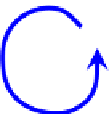Biomedical Engineering Reference
In-Depth Information
Cells operate with an analogous system.
Figure 10.2
displays the central dogma of biology,
further exemplifying from
Fig. 10.1
. Information is stored on the DNA molecule. The stored
information can be replicated directly to form a second identical molecule. Further segments
of information on the molecule can be transcribed to yield RNAs. Using a variety of RNAs,
Protein
Lab
DNA
RNA
Viruses
and/or
Lower life forms
Viruses
FIGURE 10.1
The flow of biological information in living systems.
DNA
DNA
Replication
DNA
⇒
DNA
DNA Polymerase
Reverse
transcription
RNA viruse
Transcription
DNA
RNA Polymerase
⇒
RNA
Protein binds to regulate
transcription
Translation
Ribosome
Protein
FIGURE 10.2
The central dogma is the primary tenet of molecular biology, which applies to all living organisms.
DNA serves as the template for its own replication, as well as transcription to RNA. The information transcribed into
the RNA can then be translated into proteins using an RNA template. The information on the DNA molecule is time
independent at a timescale much longer than RNA, then protein. The information exists in the form of RNA andmore
so protein molecules depends on the history and environment of the cell and is more clearly time dependent. Some of
the proteins interact with DNA to control which genes are transcribed in response to the environment.

































































Search WWH ::

Custom Search